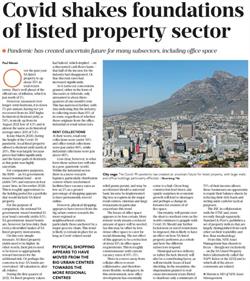Uncertainty ahead for listed property sector
The pandemic has created uncertain future for many subsectors, including office space


Over the last year, South African listed property is up about 30% in total return terms; well ahead of the official rate of inflation which is currently just north of 5%.
Measured over longer-term horizons, however, it is down 5% per annum, having not yet recovered from its 2017 highs. Its historical dividend yield, at 7.6%, is nicely up from its August 2021 lows of 4.3% and is almost the same as its historical average since 2011 of 7.4%.
In late March 2020, during the height of the Covid pandemic, local listed property offered a dividend yield north of 20%. This was largely because prices had fallen significantly and the future path of dividends at that point was highly uncertain.
For comparative purposes, the R186 – a South African government-issued nominal bond – currently yields 7.8% and matures in four years’ time in December 2026. This is roughly approximate to the holding period for a portfolio that would include South African listed property.
For the purpose of comparison, the notional South African government-issued nominal 10-year bond currently yields 9.5%. South African government-issued bonds are, however, far less risky than even a diversified basket of South African listed property instruments.
On this very simple measure, South African listed property yields need to be higher. In other words, their prices need to be lower to appropriately reward investors for the additional risk. Or perhaps the converse is true: South African bonds are overvalued. All valuation, after all, is relative.
During the first quarter of 2021, South African listed property values had halved which implied, on a discounted cash flows basis, that half of the income for the industry had disappeared - or that discount rates had increased massively.
As it turns out, concessions granted, either in the form of discounts or deferrals, only amounted to approximately three-quarters of one month’s rent. This has narrowed further with data indicating that the industry is collecting more than 95% of its rents, regardless of whether those originate from the office, industrial or retail sub-sectors. At their worst, retail rent collections were under 50%, office rental collections were just under 80%, while industrial was just above 80%.
Less clear, however, is what form these sub-sectors will take in a post-pandemic world. Within the industrial sector there is a move toward logistics, particularly distribution centres where modernised facilities have vacancy rates as low as 2%, as a greater percentage of shopping appears to have permanently moved online.
Physical shopping, however, appears to have moved from the big urban centres toward the more regional or neighbourhood centres, particularly those anchored by a major grocery chain. This trend is likely to remain in place for as long as Covid-related social relief grants persist, and which may be accelerated should a universal basic income be implemented. Big box occupiers in the major retail centres, cinemas and large restaurants in particular, exacerbate this trend.
The future of office space appears to be less certain. More remote work means a reduced amount of space will be needed but this may be offset by less dense office space to cater for greater social distancing. The net effect of this appears to be an approximately 10% reduction in office space requirements. This is roughly commensurate with currently vacancy rates of 10 to 15%.
There is a move away from cellular offices to more collaborative, and therefore more flexible, workspaces. In this environment, new office development has essentially come to a halt. Given long construction lead times, any upside surprises in economic growth will lead to shortages and perhaps a change in fortunes for owners of office space.
Uncertainty will persist over the short to medium-term as the world continues to grapple with Covid. Should any further lockdowns or travel restrictions be imposed this is likely to have an impact on how South African listed property performs as a whole and how the different sub-sectors respond.
Municipal service delivery, or rather the lack thereof, will also be a contributing factor, as will inevitable bouts of load shedding. In the meantime, the dispensation granted to REITs to distribute only a minimum of 75% of their income allows these businesses an opportunity to repair their balance sheets by reducing their debt loads and setting aside cash for tactical purposes.
The JSE, in collaboration with FTSE, and, more recently though separately, Standard and Poor’s, publish a set of property indices, largely distinguished from each other on their tradability and free-float methodology, from which NFB Asset Management has chosen to focus, though not exclusively, on the SA Listed Property Index (alternatively called the SAPY Index or the J253) and to which all of the above comments are related.
 |
The article "Covid shakes foundations of listed property sector" was printed on page 10 in Business Day on 10 January 2022 |













